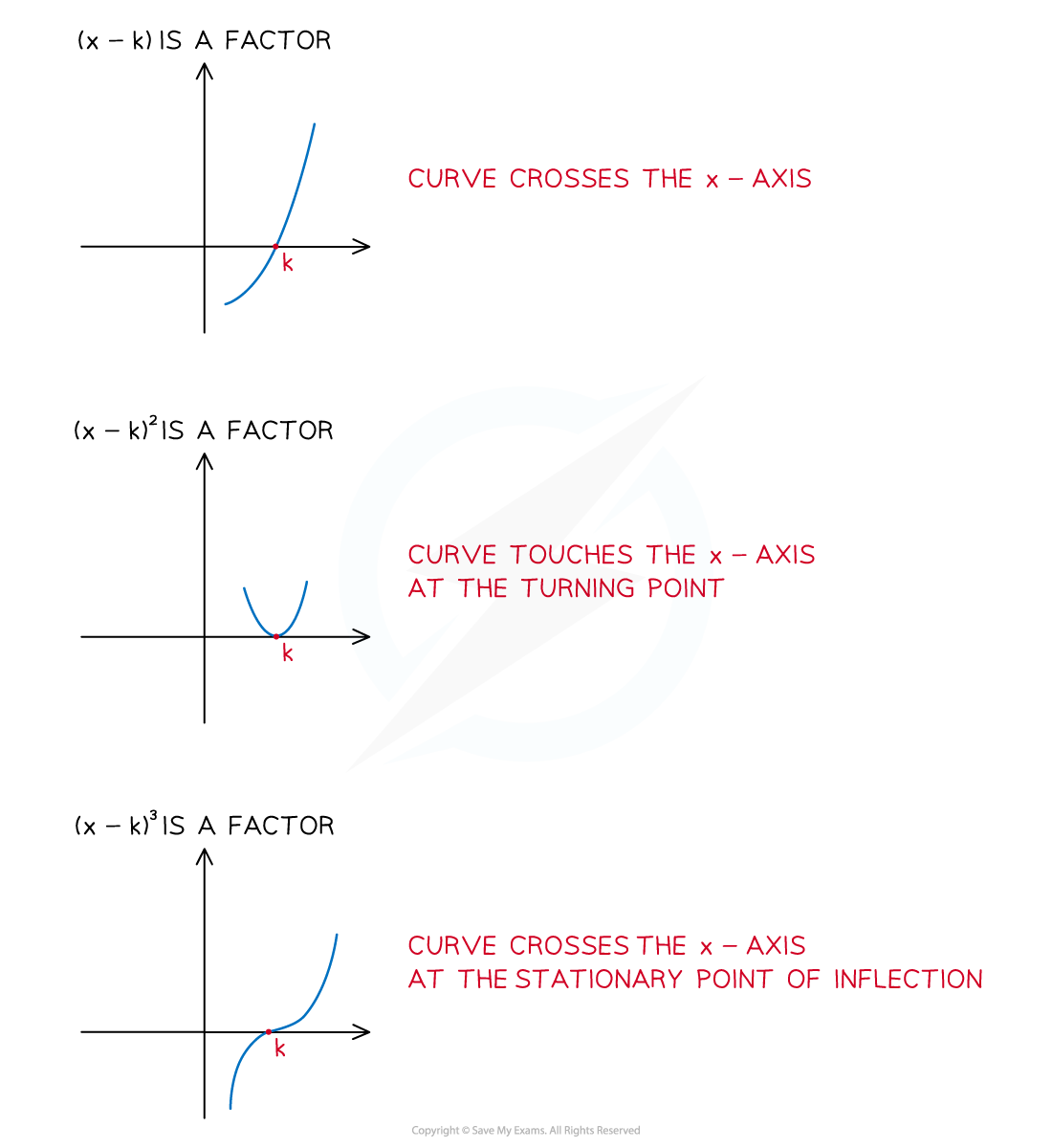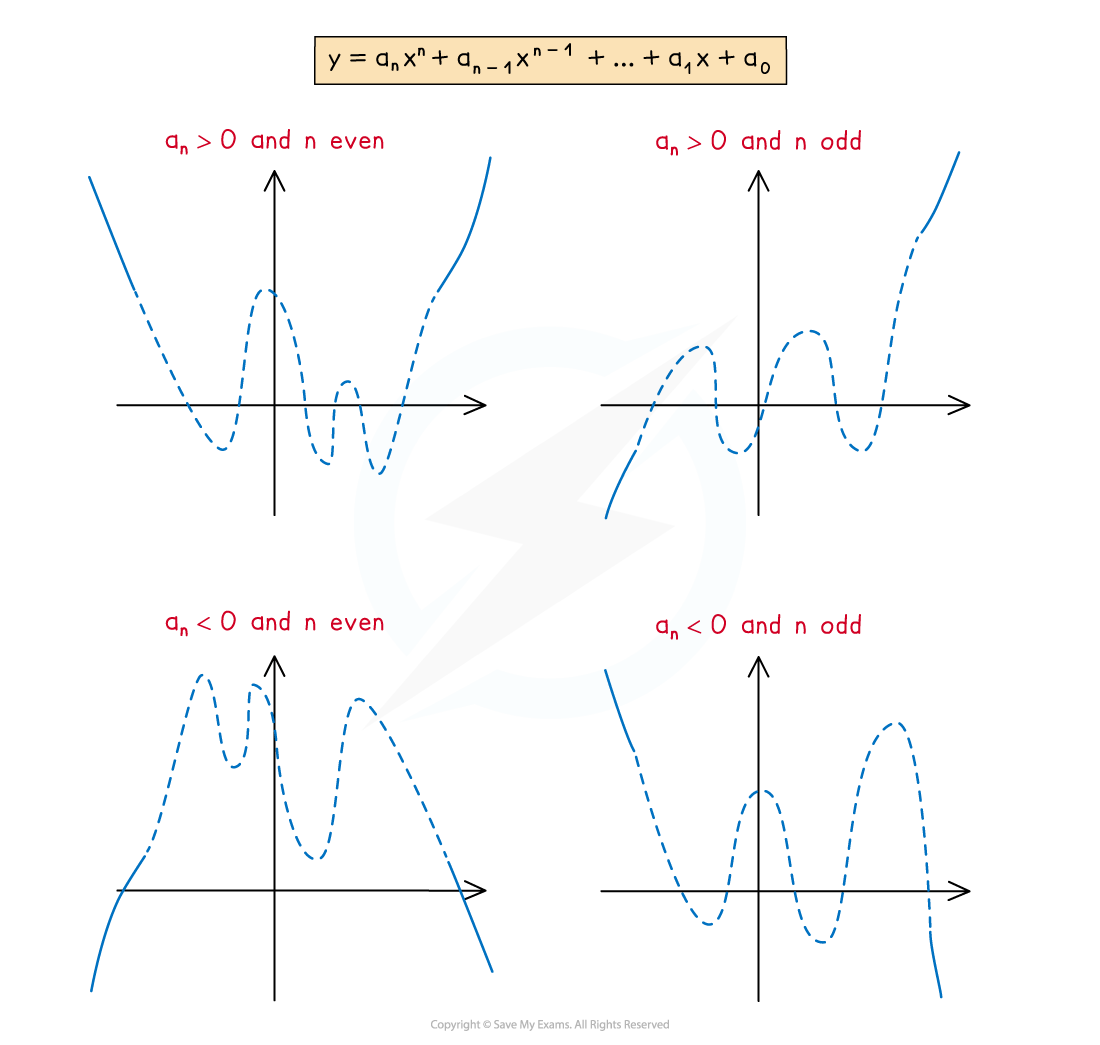Graphs & Roots of Polynomial Functions (DP IB Analysis & Approaches (AA)): Revision Note
Sketching polynomial graphs
What is a polynomial?
A polynomial is a sum of terms of the form
where
is a real number
is an integer
A polynomial looks like
The degree of a polynomial is its highest power
e.g. the degree of
is 3
e.g. the degree of
is 1
The leading term of a polynomial is the term with the highest power
e.g. the leading term of
is
What’s the relationship between a polynomial’s degree and its zeros?
If a real polynomial
has degree n
it will have n zeros which can be written in the form
, where
these zeros are not necessarily distinct
they can be repeated
For example:
A quadratic will have 2 zeros
A cubic function will have 3 zeros
A quartic will have 4 zeros
Every real polynomial of odd degree has at least one real zero
What do I need to know to sketch the graph of a polynomial function?
Suppose
is a real polynomial with degree n
To sketch the graph of a polynomial you need to know three things:
The y-intercept
Find this by substituting x = 0 to get
The roots
You can find these by factorising or solving y = 0
The shape
This is determined by the degree (n) and the sign of the leading coefficient (
)
How does the multiplicity of a real root affect the graph of the polynomial?
The multiplicity of a root is the number of times it is repeated when the polynomial is factorised
If
is a root with multiplicity m then
is a factor of the polynomial
The graph either crosses the x-axis or touches the x-axis at a root x = k where k is a real number
If
has multiplicity 1 then the graph crosses the x-axis at
If
has multiplicity 2 then the graph has a turning point at
so touches the x-axis
If
has odd multiplicity m ≥ 3 then the graph has a stationary point of inflection at
so crosses the x-axis
If
has even multiplicity m ≥ 4 then the graph has a turning point at
so touches the x-axis

How do I determine the shape of the graph of the polynomial?
Consider what happens as x tends to ± ∞
The leading coefficient | The degree | The graph approaches from the... | The graph tends to the... |
|---|---|---|---|
positive | even | top left | top right |
negative | even | bottom left | bottom right |
positive | odd | bottom left | top right |
negative | odd | top left | bottom right |

How do I sketch the graph of a polynomial function?
Plot the y-intercept
Plot the roots
Identify the multiplicity of each root
Identify where the graph starts and ends
Connect the points using a smooth curve
There will be at least one turning point in-between each pair of roots
If the degree is n then there is at most n – 1 stationary points
Every real polynomial of even degree has at least one turning point
Every real polynomial of odd degree bigger than 1 has at least one point of inflection
Examiner Tips and Tricks
If it is a calculator paper, then you can use your GDC to find the coordinates of any turning points.
If it is the non-calculator paper, then you will not be required to find the turning points when sketching unless specifically asked to.
Worked Example
a) The function is defined by
. Sketch the graph of
.

b) The graph below shows a polynomial function. Find a possible equation of the polynomial.


Solving polynomial equations
What is the fundamental theorem of algebra?
The fundamental theorem of algebra states that every real polynomial with degree n can be factorised into n complex linear factors
Some of which may be repeated
This means the polynomial will have n zeros (some may be repeats)
Every real polynomial can be expressed as a product of real linear factors and real irreducible quadratic factors
An irreducible quadratic is where it does not have real roots
The discriminant will be negative: b2 – 4ac < 0
If a + bi (b ≠ 0) is a zero of a real polynomial
then its complex conjugate a – bi is also a zero
Every real polynomial of odd degree will have at least one real zero
How do I solve polynomial equations?
Let
where
is a real polynomial of degree n
In your exam
you may be given one zero
or you might have to find a zero
You can do this by substituting values into
until it equals 0
If you know
is a real root
then
is a factor
If you know
is a non-real root
then you know a quadratic factor
This can be written as
And it simplifies to
You can use polynomial division to divide
by a factor to get another factor
e.g. dividing a cubic by a linear factor will give you a quadratic factor
You then may be able to factorise this new factor
You can solve the polynomial equation once you know all of its factors
Worked Example
Given that is a zero of the polynomial defined by
, find all three zeros of
.


Unlock more, it's free!
Did this page help you?